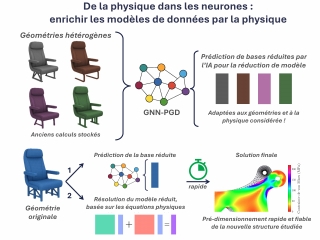Physics in neurons: enriching data models with physics
This PhD thesis tackles a major industrial challenge for Safran: reducing the computation time required to design complex mechanical structures, such as aircraft seats, despite large variations in geometry and topology. Traditional reduced-order modeling (ROM) methods remain limited to slightly variable configurations and fail to generalize across highly heterogeneous structures. To overcome these limitations, a hybrid AI–ROM framework was developed, combining physics-based modeling and machine learning. It relies on a graph neural network (GNN) that predicts a reduced basis from unstructured meshes, followed by a projection-based dynamic solver with adaptive enrichment to ensure physical consistency. Additional neural modules were also designed to accelerate existing industrial nonlinear solvers. The methodology was validated on two original datasets inspired by Safran use cases, achieving up to 70% reduction in computation time with no significant loss of accuracy, paving the way for a reliable and physically consistent integration of AI into industrial simulation workflows.
Composition du jury :
- Mme Stéphanie CHAILLAT-LOSEILLE, Directrice de recherche CNRS, Laboratoire POems (UMR 7231 CNRS-INRIA-ENSTA), rapporteuse
- M. Elías CUETO, Professeur des universités, Universidad de Zaragoz, rapporteur
- M. Francisco CHINESTA, Professeur des universités, PIMM LABORATORY (CNRS - UMR 8006, ENSAM), examinateur
- M. Daniel RIXEN, Professeur des universités, Technische Universität München (TUM), examinateur

